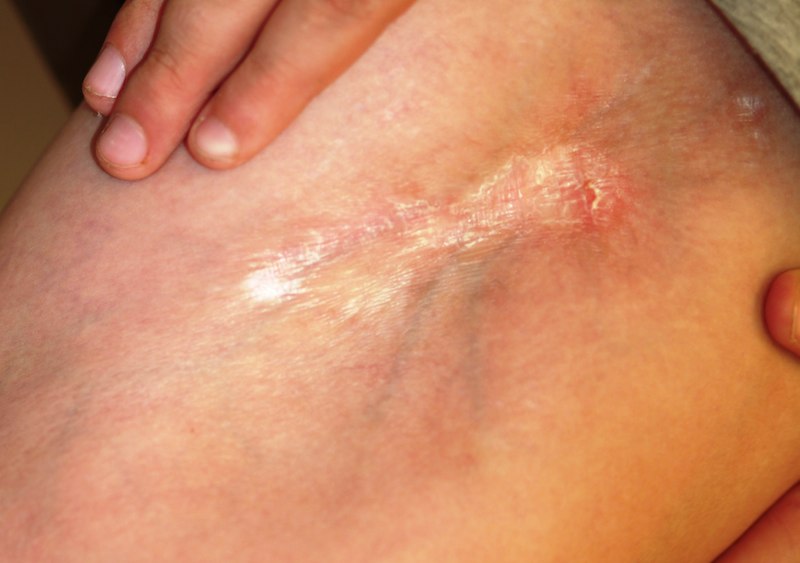Morphea, also known as localized scleroderma, is a rare skin condition that causes patches of skin to harden and become scarred. These hardened areas, which can vary in size and shape, are a result of excess collagen production that disrupts the normal skin structure. While morphea primarily affects the skin, in severe cases, it can also involve underlying tissues and organs. Understanding the causes, symptoms, diagnostic methods, and treatment options for morphea is essential for managing the condition effectively and minimizing its impact on patients’ lives.

What is Morphea?
Morphea is a type of localized scleroderma, which refers to a group of diseases that cause the skin and other tissues to harden due to an overproduction of collagen. Unlike systemic sclerosis, which affects multiple organs, morphea typically impacts only the skin and sometimes the underlying tissues. The affected skin areas can become thickened, discolored, and scarred, leading to physical and aesthetic challenges.
Types of Morphea
There are several distinct types of morphea, each characterized by different patterns and severity of skin involvement:
- Plaque Morphea: The most common form, plaque morphea presents as well-defined, raised patches on the skin that can be white, purple, or red in color. These patches may gradually expand and thicken.
- Generalized Morphea: This type involves multiple areas of thickened skin that spread across large regions of the body. It can be more challenging to treat and may lead to significant physical limitations.
- Linear Morphea: This variant of morphea appears as a line or streak of thickened skin that may run along a limb or the forehead. Linear morphea can cause significant functional issues, particularly if it affects the joints or deeper tissues.
- Deep Morphea: This form extends beyond the skin into the underlying muscles and bones, potentially leading to muscle atrophy or joint contractures. It is less common but more debilitating.
- Bullous Morphea: In this rare form, fluid-filled blisters develop on the skin patches, adding an extra layer of complexity to the disease.
Symptoms of Morphea
The primary symptom of morphea is the development of hard, thickened skin patches. These patches may be white, yellow, or purple and can cause discomfort, but they usually do not hurt. Over time, the affected skin may become tighter, and the affected areas may shrink. Symptoms associated with morphea include:
- Skin Changes: The most noticeable symptom is the appearance of thickened, hardened areas of skin. These patches can be raised, shiny, and smooth, and may have a different color than surrounding skin.
- Loss of Skin Flexibility: As the collagen in the skin increases, the skin becomes less flexible. This can result in stiffness and difficulty moving the affected areas, particularly if the skin on joints is involved.
- Itching or Pain: While the skin patches themselves are usually painless, they may cause mild itching or discomfort. In some cases, deep morphea may result in pain due to the involvement of underlying tissues.
- Hair Loss: Hair may fall out from areas affected by morphea, contributing to the aesthetic impact of the disease.
- Joint and Muscle Involvement: If morphea affects deeper tissues, such as muscles or bones, it can lead to restricted movement and joint contractures, which may cause pain or weakness.
Causes of Morphea
The exact cause of morphea remains unclear, but several factors are believed to contribute to the development of the condition:
- Autoimmune Response: Morphea is considered an autoimmune disorder, where the body’s immune system mistakenly attacks its own tissues, leading to the overproduction of collagen in the skin.
- Genetic Factors: There is evidence to suggest that a genetic predisposition may play a role in the development of morphea. Family history and certain genetic markers may increase the risk of the condition.
- Environmental Triggers: Exposure to certain environmental factors, such as infections or trauma to the skin, may trigger morphea in susceptible individuals.
- Hormonal Factors: Morphea is more commonly diagnosed in women, particularly those in their 30s to 40s, suggesting that hormonal changes could influence its development.
- Other Autoimmune Conditions: Individuals with other autoimmune diseases, such as rheumatoid arthritis or lupus, may be at an increased risk of developing morphea.
Diagnosis of Morphea
Diagnosing morphea typically begins with a physical examination, where the doctor will look for characteristic skin changes, such as thickened patches and color variations. To confirm the diagnosis and rule out other conditions, further tests may be conducted:
- Skin Biopsy: A small sample of the affected skin may be removed and examined under a microscope. The biopsy can help confirm the presence of excessive collagen and distinguish morphea from other skin disorders.
- Blood Tests: While blood tests are not specific for morphea, they can help rule out other autoimmune diseases and check for markers of inflammation or infection.
- Imaging Studies: In cases where deep morphea is suspected, imaging tests like ultrasound or MRI may be used to assess the extent of tissue involvement beyond the skin.
- Disease Activity Assessment: Some doctors may use standardized scales or questionnaires to evaluate the severity and progression of the disease, helping to guide treatment decisions.
Treatment Options for Morphea
Although there is no cure for morphea, treatment aims to manage symptoms, prevent the condition from worsening, and improve quality of life. The choice of treatment depends on the severity, type, and location of the disease.
1. Topical Treatments
For mild cases of morphea, topical treatments can be effective:
- Corticosteroids: Topical steroids are often prescribed to reduce inflammation and prevent further skin thickening. They may also help alleviate discomfort and itching.
- Topical Calcineurin Inhibitors: Medications such as tacrolimus or pimecrolimus may be used as alternatives to steroids, especially when the affected areas are sensitive, such as around the face or eyes.
2. Systemic Treatments
For more severe cases or those that involve deeper tissues, systemic treatments may be required:
- Oral Corticosteroids: When topical treatments are insufficient, oral corticosteroids may be prescribed to suppress the immune system and reduce inflammation throughout the body.
- Methotrexate: This immunosuppressive drug is commonly used to treat autoimmune conditions and can be effective in managing more severe forms of morphea, particularly when other treatments fail.
- Phototherapy: Ultraviolet (UV) light therapy, especially UVA1, can help reduce skin thickening and improve flexibility by reducing the overproduction of collagen.
3. Physical Therapy
If morphea affects joints or muscles, physical therapy may be recommended to maintain mobility and prevent joint contractures. Stretching exercises and other rehabilitative techniques can help maintain range of motion and prevent stiffness.
4. Surgical Interventions
In rare cases, if morphea causes significant tissue damage or deformities, surgery may be considered to remove or repair affected tissues. However, this is generally only recommended when all other treatment options have been exhausted.
Managing Morphea: Lifestyle and Prevention
While there is no guaranteed way to prevent morphea, certain lifestyle changes and precautions can help manage the disease and reduce flare-ups:
- Sun Protection: People with morphea should avoid prolonged sun exposure and use broad-spectrum sunscreen, as UV rays can worsen skin damage and trigger flare-ups.
- Stress Management: Since stress may exacerbate autoimmune conditions, practices such as meditation, yoga, and other relaxation techniques can help manage symptoms.
- Regular Follow-ups: Since morphea can fluctuate in severity, regular check-ups with a dermatologist are essential to monitor disease progression and adjust treatment plans as needed.
Morphea is a challenging condition that can significantly affect a person’s skin, mobility, and overall quality of life. While its exact cause remains unclear, advances in treatment options offer hope for those affected. With proper diagnosis, timely intervention, and a comprehensive treatment approach, it is possible to manage morphea effectively and prevent complications.

